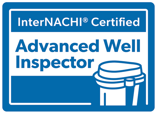
Purpose of Well Pump Flow Test
The primary objective of the Well Pump Flow Test is to evaluate the visible components of a property's water system and assess its capacity to supply water reliably. The inspection provides the property buyer with a comprehensive report on the system's condition at the time of inspection, highlighting potential maintenance issues and capabilities of the water supply. It is important to underscore that the inspection does not verify the potability of the water or guarantee that the water supply will meet all the buyer’s needs.
Components of the Inspection Include:
- Historical Records Review:
- Compilation and review of all accessible records, including the original well report, maintenance logs, and previous water tests, to provide the buyer with a thorough understanding of the well's history.
- Inspection of Interior Water Components:
- Examination of household water outlets such as sinks, showers, and toilets to check for leaks and signs of mineral or bacterial deposits, which could indicate underlying issues with the water system.
- Pumps and Pressure System Evaluation
- Detailed assessment of the pump, pressure tank, tank tee, and components, focusing on type, functionality, and condition. This includes testing for amperage fluctuations, evaluating corrosion levels, verifying pressure settings, and ensuring the operational efficiency of the tank system.
- Well Components Examination
- Thorough inspection of the well’s physical location, casing, and cap to determine there is no risk of contamination and that all components meet health and safety regulations.
- Comprehensive Water Flow Test
- Conducting an intensive flow test to determine the well’s ability to maintain a consistent flow rate, thus evaluating the pump’s performance and estimating the well’s capacity to achieve equilibrium under usage demands.
Additional Services:
- Optional Water Sampling and Testing:
- While not included as a standard part of the well inspection, water testing is strongly recommended to detect potential contaminants that may necessitate treatment solutions.
- SureWorx Inspection Services Inc. provides water sampling on request. A third-party certified laboratory conducts lab results, and SureWorx Inspection Inc. takes no responsibility for their results. The homebuyer should compare all sample results with the Government of Alberta's local guidelines or a health specialist. Canadian Drinking Water Guidelines.
Exclusions:
- Water Treatment Devices:
- The inspection does not cover water treatment systems directly; however, any observed issues with these systems may be noted as a courtesy.
- If filtration is required, I recommend contacting a water filtration specialist or contractor for proper filtration and the costs involved.
Conclusion and Recommendations:
This inspection is designed to arm the buyer with crucial information regarding the functionality and condition of the water well system, aiding in informed decision-making regarding property acquisition. If any concerns arise during the inspection, further testing or consultations with specialized professionals, such as water well contractors or water treatment experts, may be recommended.
For more information about working wells please visit Alberta Working Wells - Resources